SUBHEAD: Looking at more detail underlying History Channel’s “Prophets of Doom” story.
By Gail Tverberg on 6 January 2011 in Our Finite World -
(http://ourfiniteworld.com/2011/01/06/the-oil-employment-link-part-2-looking-at-more-detail-underlying-history-chanels-prophets-of-doom-story/#more-546)

Image above: Mashup of two stills from video below, "Prophets of Doom"
.
In Part 1, I talked about how there is a close tie between the amount of oil consumed and the number of people employed. US oil imports have been dropping, and there are strong indications that they may continue dropping–world supply is flat, and China, India, and oil exporter are taking a larger share of the total. It appears to be almost impossible to ramp up US oil production by a very large amount, so with smaller and smaller imports, it is likely that US oil consumption will continue to decline, and with it the number of people employed in the US.
The problem is that our financial system cannot stand a very high unemployment rate–perhaps double today’s unemployment rate, or greater. If there is very high unemployment, people will default on their debt, and banks and insurance companies will fail. There appears to be a very high probability that the financial system as a whole may fail.
Video above: "Prophets of Doom". From (http://www.youtube.com/watch?v=nSpLUpiMkj0)
Some of you may have seen the show Prophets of Doom on the History Chanel (Wednesday, Jan. 4). What I am talking about is very much related to the collapse scenarios discussed on that show, although I would not necessarily describe things exactly the same way that participants on that show described things. Also, the ideas I am presenting are my own. Presenters on that program would likely have somewhat different ideas.
Let’s go back to the last chart I showed in Part 1, showing my idea of how I expect employment to change in the future.
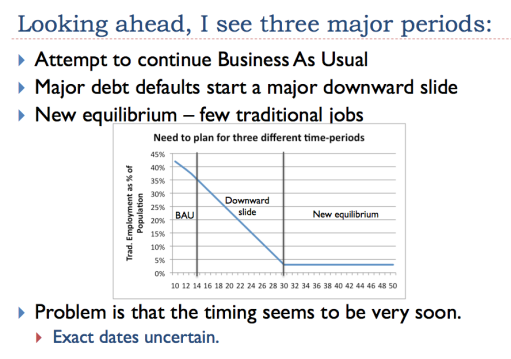
In this slide, I show my estimate of job counts divided by population, based partly on relationships I develop in Part 1, and partly on my view of how things might work out.
The number of people with non-farm jobs drops as a percentage of the population, until it reaches an equilibrium low level, in about 2030. I would expect that virtually no fossil fuels would be used at that time, nor would uranium be used. Society would exist without electricity, and without the conveniences we are used to today. Local farming jobs and goods produced by local craft jobs would grow, but would not be included in these employment counts.
The reason my forecast is so dire is the fact that all of our systems are highly networked – our transportation system, our financial system, our international trade system, our internet system, our electrical system, our food system, our federal, state and local governments, and many other systems. If one system fails, it is likely to bring down other systems as well, and eventually the overall system. This is very much related to the point I made in Part 1, that if oil use declines, the use of other fuels is likely to decline as well (as it did in 2009) because the decline in oil use causes recession and decline in demand for other fuels.
A big question is to what extent our financial system fails and cannot immediately be replaced. If there are huge amounts of unpaid debts (say 20% of mortgages, and 20% of municipal bonds, and 20% of commercial loans), it will become apparent that many countries will be unlikely to pay their international debts. The International Monetary Fund will likely be overwhelmed by the size of the problem, and trust may in whole system may rapidly decline.
One question is whether banks and insurance companies can be propped up. We have seen how banks and insurance companies could be propped up in 2008, and I expect that countries will try to do more of the same. But eventually, major cracks are going to develop in the system. Interest rates are likely to rise to 20% or more, because of the high default rates on loans.
The value of some currencies is likely to drop to close to $0 for use in international trade, if prospective sellers don’t think they have sufficient chance of getting adequate goods in return for the goods (perhaps oil) that they are selling.
The problem is a likely to be a growing mismatch between what money is supposedly worth, and the amount of goods and services the economy is actually producing.
The purported value of money will rise over time, as money is loaned into existence, and borrowers at least try to pay pack their loans, plus interest. (In Prophets of Doom, Nate Hagens refers to this growing monetary amount as a “Ponzi Scheme”.) But the real value of goods and services made is likely to decline in the future, as the amount of oil and other inputs declines. How fast this occurs is not entirely clear, but Slide 18 gives an idea.
As the amount of oil consumed falls, the number of people with jobs declines, and the amount of goods those employees can make or obtain through trade with other economies declines. Eventually, the amount of goods and services the world can support with only natural inputs will drop to a much lower level than what we are producing today.
With this mismatch between the purported value of money and much lower value of goods and services actually being produced, the financial system will run into all kinds of issues. As mentioned previously, there will be many debt defaults. There is likely to be a question as to who gets collateral on defaulted loans. Those selling internationally may be hesitant to sell to those with poor credit. With fewer people employed, governments will have more and more difficulty collecting taxes, and more and more trouble providing promised services.
It seems to me that to some extent the unraveling of the financial system (and related systems like food and transportation) will be gradual. We saw the beginning of this unravelling in 2008, and we can expect to see more over time. Most of the unsustainablity of our current system has been temporarily hidden by stimulus payments that federal governments around the world are making, but are not collecting adequate taxes for.
As legislatures refuse to authorize more spending and as taxes are raised, the real problems will become more apparent–more people will be laid off from work, and nations will sink further and further into recession. I showed in Is it possible to raise taxes enough to fix the deficit? that it appears that taxes would need to be raised by about 40% to match current spending levels–something that seems highly unlikely. It seems to me that big cuts in programs will be needed to bring spending down to what the country can afford.
Getting back to Slide 18, above, it seems to me that we will see a slide in conventional employment over a period of years, which I have shown as about 20 years. Part of what will hold things up is the fact that we currently have homes and cars and computers and machinery for planting corn and other crops, and much other built infrastructure.
Even if we start getting some interferences with trade, we can still use the machinery that we already have. But over a period of time, this ability is likely to seriously deteriorate. I estimate it will be about 20 years before the deterioration will be so great that we will need to transition to a new system without fossil fuels, if we are to continue producing things. I see the biggest problems in making high tech equipment, like computers and wind turbine gear boxes, because they require materials meeting very stringent specifications.
We will likely be able to make low tech equipment (like wheelbarrows) out of recycled material from cars and buildings for many years.
In my view, the maintenance of almost universal electricity is extremely important. This, too, is likely to unravel, partly from lack of replacement parts, and partly because of financial problems of the electric utilities (because their customers cannot pay their bills). There may be other issues as well–lack of ability to maintain the transmission lines, and lack of internet access for functions associated with transmission regulation. Lack of fuel may play a role as well, if transportation systems are in poor repair, or banks are closed, and cannot facilitate transactions (buying coal from Wyoming for use in Georgia, for example). I expect wind turbines will stop functioning about the same time as everything else–perhaps sooner, if getting replacement parts is a problem.
In Slide 18, I show the first three or four years as perhaps the period when there is a pretense that this is just a temporary aberration, with most believing that Business as Usual is just around the corner. Most people will believe that the world will soon return to growth, and all that needs to happen is for lenders to extend the terms of loans a bit, and maybe raise interest rates a bit.
But as more and more countries default on their debt, and the situation gets worse and worse, this belief in an underlying BAU situation will be less and less tenable. It is possible that quite a few governments will be overthrown, country boundaries will be redrawn, and new leaders will step in. There may be both international and local fighting for resources. All of this will tend to speed up the rate of economic decline.
I suppose that this might theoretically be prevented, if it is possible to invent–quickly–a new financial system that will contract as the amount of goods and services available contracts, and that will allow trade to go on as usual. The problem I see, though, is that many potential buyers of goods really will have little to trade in return; changing the financial system does not change this reality, and the decline in raw materials will tend to make the situation worse and worse over time. It will be only the parts of the world that are able to continue to grow food or manufacture goods or extract minerals that will have much to trade.
Eventually, as electricity is completely lost, and as world trade deteriorates to a much lower level, I expect that the world will return to a situation where most of the population will make a living by local agriculture or by local crafts. This is the equilibrium stage that I show being reached around 2030. I see this rapid deterioration because I do not see substitution as being very possible in the short-term, and because I see the various systems (oil, financial, food, etc.) as so closely linked.

Most of these things I mentioned above. I should point out that if we lose electricity, we lose a lot of other things. Our fresh water systems depends on electricity. Our sewer treatment plants run on electricity. Nearly all of our medical treatments require electricity, and more and more of our health records are stored online. Gasoline pumps use electricity, and most heating systems use electricity at some point in their operation. If heating systems allow homes to drop below freezing, pipes will freeze, and severe damage is likely to take place.
One thing I didn’t mention previously is the fact that the death rate is likely to rise, as problems start occurring with food, water, health care, and other services. It is not clear how quickly this will happen. It will really depend on how well we can keep systems for essential services (food, fresh water, cooking fuel) in place. If the current system stops functioning, we will need to be able to transition to a replacement system using only local inputs quickly.
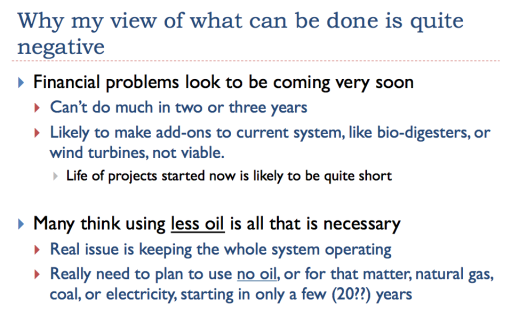
The big issue I see is we have very little time for mitigation, because our major financial problems seem to be coming very soon. I say two or three years in the slide, but we have so many hidden debt problems already in existence that we may see major financial problems much sooner–say six months.
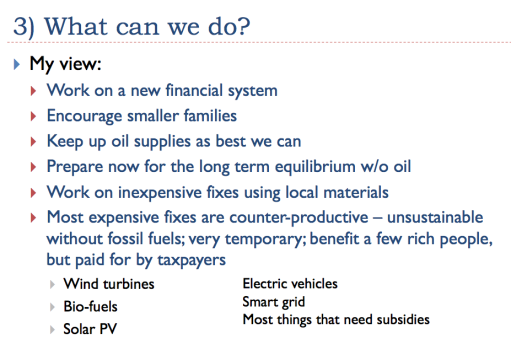
This is my summary of the major steps I see needed. I have a separate slide on each.

As I discussed above, our current financial system needs to be replaced. It may be that we really need two systems–a rapidly contracting one for the downslide period, which I have hypothesized to be 20 years, followed by a much simpler one for that equilibrium period that follows. It is possible that a metal coin system will work for the equilibrium period, since by then, even making paper money may be difficult.
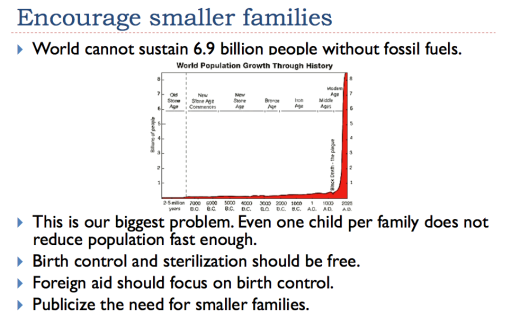
Population is really the number one problem we are facing. Without fossil fuels, the world will only be able to support a much lower population than what we have today, because our current systems for growing and transporting food are heavily dependent on fossil fuels. We can look at past population levels to get an idea of the population that perhaps can be supported. If we can develop sustainable farming without fossil fuels, then perhaps the drop in world population can be stopped at, say, a level of 1 billion, compared to today’s population of 6.9 billion. But if we can’t figure sustainable farming out, population could drop even further–theoretically to the level of the population of hunters and gatherers in times past–maybe less than 100 million.
I suggest encouraging smaller families, but this is likely to make only the tiniest dent in the problem. Of increasing population will make the problem worse.
There are a number of people who talk about “steady state” or “no growth” economies. I see these economies as only possible with a population that is very much lower than the world’s population today. I do not think most current transition agriculture (using organic methods or permaculture) is sustainable at today’s yield levels without oil and electricity.
Current approaches get indirect help from our fossil fuel system–transportation of soil amendments to the farm, refrigeration for produce (so less is lost after harvest), electric fences, oil to run tractors, electricity for water pumps. Once help from fossil fuel is lost, farming methods will need to be simplified even further, resulting in lower food production per acre and per farmer.
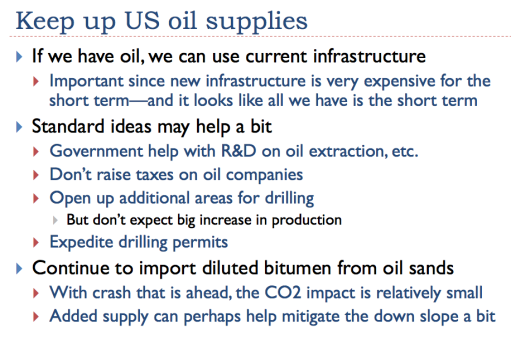
I don’t see that many of the proposed add ons to the current system (such as wind turbines, solar PV, and electric cars) will do much to sustain the economy for the long term, so it seems to me that we need to at least hold off the collapse as best we can in the near term, and try to keep things together. It is popular to bash the oil and gas industry, but we really very much need them, if we are to keep our systems together, for even the very near term.
As I noted in Part 1, our oil imports are likely to keep dropping because world oil supplies are at best level, and countries like China and India are outbidding us on the demand side. If we do not want our total oil consumption to drop too dramatically, we need to maintain US production as best we can.
There are people who talk romantically about being about to “walk away from fossil fuels” or voluntarily do without. I don’t see this as possible or useful. If some countries voluntarily reduce consumption, it will increase oil available to other countries, and help them live better, but I don’t think it will have any impact on the long term. To the extent that a voluntary reduction in fuel use disrupts current systems (for example, causes utility companies to go bankrupt), it is possible that it will bring earlier collapse to the system, and a steeper overall decline, both in employment and population.
Everything I see suggests that population and oil and other fossil fuel consumption will drop very quickly, regardless of what we do. So trying to hold up oil production in the short term will have little impact on long term CO2 levels. In the scenario I envision in Slide 18, the amount of new manmade CO2 emitted will drop very rapidly, effectively reaching zero by 2030, whether or not we try to keep US oil production up in the near term. This drop to effectively 0 by 2030 is a much more rapid reduction than climate change activists are asking for.

I think we need to get started preparing for a post fossil-fuel era right now, because it is such a huge undertaking. Even if I am wrong as to the speed with which fossil fuels will leave us, and we can continue fossil fuel consumption until say, 2050 or 2080, instead of 2030, I still think we need to start preparing for the change now.
I list several transition needs in my list. Some of these are law changes. There are many others. For example, economics theory will need to be completely rethought. Political systems will likely need to change greatly as well.
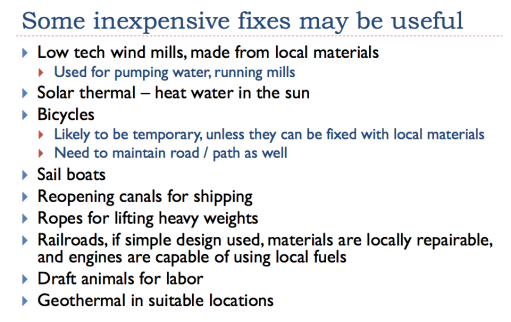
I see inexpensive fixes as being the ones to pursue–partly because they are the ones that are most likely to be sustainable for the long run, and partly because they will be most easy to finance with our current financial problems.

I see most of the high priced fixes that are being touted today as being simply add-ons to our current fossil fuel powered system. Without fossil fuels, we will not be able to manufacture any more wind turbines, or solar PV panels, or electric cars, and we won’t be able to service the ones we have. Bio-digesters will have much less fuel, and will be difficult to keep in repair. So I don’t see much point in building more of them–especially if doing so requires a subsidy, or if their usefulness depends on maintenance of the electrical grid. There may be some that are temporarily helpful though–solar panels to power irrigation equipment, or wind to power ammonia generation.
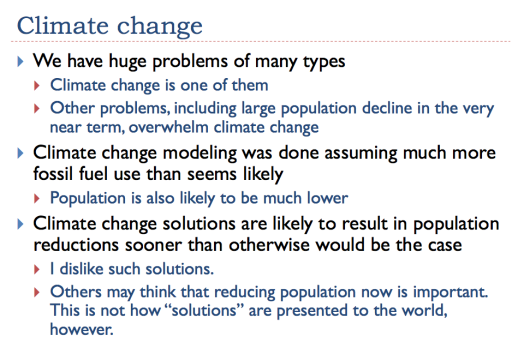
I mentioned most of these issues before, but I think they bear repeating. Even voluntary reduction of fossil fuels is likely to result in more and more job loss. With less and less in the way of government safety nets, marginalized people will find themselves unable to maintain even basic food supply. So what sounds good in theory in saving CO2 is not likely to work out well in practice.
.
By Gail Tverberg on 6 January 2011 in Our Finite World -
(http://ourfiniteworld.com/2011/01/06/the-oil-employment-link-part-2-looking-at-more-detail-underlying-history-chanels-prophets-of-doom-story/#more-546)

Image above: Mashup of two stills from video below, "Prophets of Doom"
.
In Part 1, I talked about how there is a close tie between the amount of oil consumed and the number of people employed. US oil imports have been dropping, and there are strong indications that they may continue dropping–world supply is flat, and China, India, and oil exporter are taking a larger share of the total. It appears to be almost impossible to ramp up US oil production by a very large amount, so with smaller and smaller imports, it is likely that US oil consumption will continue to decline, and with it the number of people employed in the US.
The problem is that our financial system cannot stand a very high unemployment rate–perhaps double today’s unemployment rate, or greater. If there is very high unemployment, people will default on their debt, and banks and insurance companies will fail. There appears to be a very high probability that the financial system as a whole may fail.
Video above: "Prophets of Doom". From (http://www.youtube.com/watch?v=nSpLUpiMkj0)
Some of you may have seen the show Prophets of Doom on the History Chanel (Wednesday, Jan. 4). What I am talking about is very much related to the collapse scenarios discussed on that show, although I would not necessarily describe things exactly the same way that participants on that show described things. Also, the ideas I am presenting are my own. Presenters on that program would likely have somewhat different ideas.
Let’s go back to the last chart I showed in Part 1, showing my idea of how I expect employment to change in the future.

Slide 18
The number of people with non-farm jobs drops as a percentage of the population, until it reaches an equilibrium low level, in about 2030. I would expect that virtually no fossil fuels would be used at that time, nor would uranium be used. Society would exist without electricity, and without the conveniences we are used to today. Local farming jobs and goods produced by local craft jobs would grow, but would not be included in these employment counts.
The reason my forecast is so dire is the fact that all of our systems are highly networked – our transportation system, our financial system, our international trade system, our internet system, our electrical system, our food system, our federal, state and local governments, and many other systems. If one system fails, it is likely to bring down other systems as well, and eventually the overall system. This is very much related to the point I made in Part 1, that if oil use declines, the use of other fuels is likely to decline as well (as it did in 2009) because the decline in oil use causes recession and decline in demand for other fuels.
A big question is to what extent our financial system fails and cannot immediately be replaced. If there are huge amounts of unpaid debts (say 20% of mortgages, and 20% of municipal bonds, and 20% of commercial loans), it will become apparent that many countries will be unlikely to pay their international debts. The International Monetary Fund will likely be overwhelmed by the size of the problem, and trust may in whole system may rapidly decline.
One question is whether banks and insurance companies can be propped up. We have seen how banks and insurance companies could be propped up in 2008, and I expect that countries will try to do more of the same. But eventually, major cracks are going to develop in the system. Interest rates are likely to rise to 20% or more, because of the high default rates on loans.
The value of some currencies is likely to drop to close to $0 for use in international trade, if prospective sellers don’t think they have sufficient chance of getting adequate goods in return for the goods (perhaps oil) that they are selling.
The problem is a likely to be a growing mismatch between what money is supposedly worth, and the amount of goods and services the economy is actually producing.
The purported value of money will rise over time, as money is loaned into existence, and borrowers at least try to pay pack their loans, plus interest. (In Prophets of Doom, Nate Hagens refers to this growing monetary amount as a “Ponzi Scheme”.) But the real value of goods and services made is likely to decline in the future, as the amount of oil and other inputs declines. How fast this occurs is not entirely clear, but Slide 18 gives an idea.
As the amount of oil consumed falls, the number of people with jobs declines, and the amount of goods those employees can make or obtain through trade with other economies declines. Eventually, the amount of goods and services the world can support with only natural inputs will drop to a much lower level than what we are producing today.
With this mismatch between the purported value of money and much lower value of goods and services actually being produced, the financial system will run into all kinds of issues. As mentioned previously, there will be many debt defaults. There is likely to be a question as to who gets collateral on defaulted loans. Those selling internationally may be hesitant to sell to those with poor credit. With fewer people employed, governments will have more and more difficulty collecting taxes, and more and more trouble providing promised services.
It seems to me that to some extent the unraveling of the financial system (and related systems like food and transportation) will be gradual. We saw the beginning of this unravelling in 2008, and we can expect to see more over time. Most of the unsustainablity of our current system has been temporarily hidden by stimulus payments that federal governments around the world are making, but are not collecting adequate taxes for.
As legislatures refuse to authorize more spending and as taxes are raised, the real problems will become more apparent–more people will be laid off from work, and nations will sink further and further into recession. I showed in Is it possible to raise taxes enough to fix the deficit? that it appears that taxes would need to be raised by about 40% to match current spending levels–something that seems highly unlikely. It seems to me that big cuts in programs will be needed to bring spending down to what the country can afford.
Getting back to Slide 18, above, it seems to me that we will see a slide in conventional employment over a period of years, which I have shown as about 20 years. Part of what will hold things up is the fact that we currently have homes and cars and computers and machinery for planting corn and other crops, and much other built infrastructure.
Even if we start getting some interferences with trade, we can still use the machinery that we already have. But over a period of time, this ability is likely to seriously deteriorate. I estimate it will be about 20 years before the deterioration will be so great that we will need to transition to a new system without fossil fuels, if we are to continue producing things. I see the biggest problems in making high tech equipment, like computers and wind turbine gear boxes, because they require materials meeting very stringent specifications.
We will likely be able to make low tech equipment (like wheelbarrows) out of recycled material from cars and buildings for many years.
In my view, the maintenance of almost universal electricity is extremely important. This, too, is likely to unravel, partly from lack of replacement parts, and partly because of financial problems of the electric utilities (because their customers cannot pay their bills). There may be other issues as well–lack of ability to maintain the transmission lines, and lack of internet access for functions associated with transmission regulation. Lack of fuel may play a role as well, if transportation systems are in poor repair, or banks are closed, and cannot facilitate transactions (buying coal from Wyoming for use in Georgia, for example). I expect wind turbines will stop functioning about the same time as everything else–perhaps sooner, if getting replacement parts is a problem.
In Slide 18, I show the first three or four years as perhaps the period when there is a pretense that this is just a temporary aberration, with most believing that Business as Usual is just around the corner. Most people will believe that the world will soon return to growth, and all that needs to happen is for lenders to extend the terms of loans a bit, and maybe raise interest rates a bit.
But as more and more countries default on their debt, and the situation gets worse and worse, this belief in an underlying BAU situation will be less and less tenable. It is possible that quite a few governments will be overthrown, country boundaries will be redrawn, and new leaders will step in. There may be both international and local fighting for resources. All of this will tend to speed up the rate of economic decline.
I suppose that this might theoretically be prevented, if it is possible to invent–quickly–a new financial system that will contract as the amount of goods and services available contracts, and that will allow trade to go on as usual. The problem I see, though, is that many potential buyers of goods really will have little to trade in return; changing the financial system does not change this reality, and the decline in raw materials will tend to make the situation worse and worse over time. It will be only the parts of the world that are able to continue to grow food or manufacture goods or extract minerals that will have much to trade.
Eventually, as electricity is completely lost, and as world trade deteriorates to a much lower level, I expect that the world will return to a situation where most of the population will make a living by local agriculture or by local crafts. This is the equilibrium stage that I show being reached around 2030. I see this rapid deterioration because I do not see substitution as being very possible in the short-term, and because I see the various systems (oil, financial, food, etc.) as so closely linked.

Slide 19
One thing I didn’t mention previously is the fact that the death rate is likely to rise, as problems start occurring with food, water, health care, and other services. It is not clear how quickly this will happen. It will really depend on how well we can keep systems for essential services (food, fresh water, cooking fuel) in place. If the current system stops functioning, we will need to be able to transition to a replacement system using only local inputs quickly.

Slide 20

Slide 21

Slide 22

Slide 23
I suggest encouraging smaller families, but this is likely to make only the tiniest dent in the problem. Of increasing population will make the problem worse.
There are a number of people who talk about “steady state” or “no growth” economies. I see these economies as only possible with a population that is very much lower than the world’s population today. I do not think most current transition agriculture (using organic methods or permaculture) is sustainable at today’s yield levels without oil and electricity.
Current approaches get indirect help from our fossil fuel system–transportation of soil amendments to the farm, refrigeration for produce (so less is lost after harvest), electric fences, oil to run tractors, electricity for water pumps. Once help from fossil fuel is lost, farming methods will need to be simplified even further, resulting in lower food production per acre and per farmer.

Slide 24
As I noted in Part 1, our oil imports are likely to keep dropping because world oil supplies are at best level, and countries like China and India are outbidding us on the demand side. If we do not want our total oil consumption to drop too dramatically, we need to maintain US production as best we can.
There are people who talk romantically about being about to “walk away from fossil fuels” or voluntarily do without. I don’t see this as possible or useful. If some countries voluntarily reduce consumption, it will increase oil available to other countries, and help them live better, but I don’t think it will have any impact on the long term. To the extent that a voluntary reduction in fuel use disrupts current systems (for example, causes utility companies to go bankrupt), it is possible that it will bring earlier collapse to the system, and a steeper overall decline, both in employment and population.
Everything I see suggests that population and oil and other fossil fuel consumption will drop very quickly, regardless of what we do. So trying to hold up oil production in the short term will have little impact on long term CO2 levels. In the scenario I envision in Slide 18, the amount of new manmade CO2 emitted will drop very rapidly, effectively reaching zero by 2030, whether or not we try to keep US oil production up in the near term. This drop to effectively 0 by 2030 is a much more rapid reduction than climate change activists are asking for.

Slide 25
I list several transition needs in my list. Some of these are law changes. There are many others. For example, economics theory will need to be completely rethought. Political systems will likely need to change greatly as well.

Slide 26

Slide 27

Slide 28
.
1 comment :
Every subject covered in Prophets of Doom is a symptom. No one talked about the cause of all these symptoms. No one talked about controlling population. Until that is done all these problems will continus to exist. Lowering the world population is a long term project, if done by humane ways, but it needs to be done, before the planet does it for us.
Sherman Reinius
Post a Comment